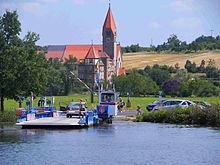St. Ludwig (Wipfeld)
St. Ludwig is a district of the municipality of Wipfeld . A ferry service connects St. Ludwig with Wipfeld, which is on the other side of the Main .
history
Mineral bath
The discovery of five sulfur healing springs was the basis for the spa operation of the Ludwigsbad, which existed from 1811 to 1901. Grand Duke Ferdinand of Tuscany promoted the mineral bath.
Benedictine monastery
After the end of the spa business in 1901, the buildings were converted into a Benedictine monastery by monks from the Archabbey of St. Ottilien and a grammar school was set up. Also in 1901 St. Ottilien appointed Father Plazidus Vogel to head this new foundation. The monastery church of the Holy Family was built between 1906 and 1909 in the neo-Romanesque style with furnishings in the style of the Beuron School , and it also contains a 2-manual organ from the Klais company from 1908. The building and expansion options came from the rapidly growing community soon to its limits in St. Ludwig. Therefore, in 1913 the monks moved to the Münsterschwarzach monastery, which had been abandoned since 1803 .
Youth welfare facility
Today (since 1965) there is a curative educational youth welfare facility for girls and young women in St. Ludwig. The Antonia Werr Center is supported by the Congregation of the Servants of the Holy Childhood of Jesus from the Third Order of St. Francis in Oberzell .
literature
- Hermann Weggartner: The Monastery of St. Ludwig am Main - Its origin and its history. Münsterschwarzach 1921.
- Adelhard Kaspar : Grand Duke Ferdinand of Tuscany, sponsor of the mineral bath near Wipfeld. In: Franconian bathing trips in old and new times, Frankenbund, Würzburg 1965 p. 62f
Web links
Coordinates: 49 ° 55 ′ 34 ″ N , 10 ° 11 ′ 3 ″ E
